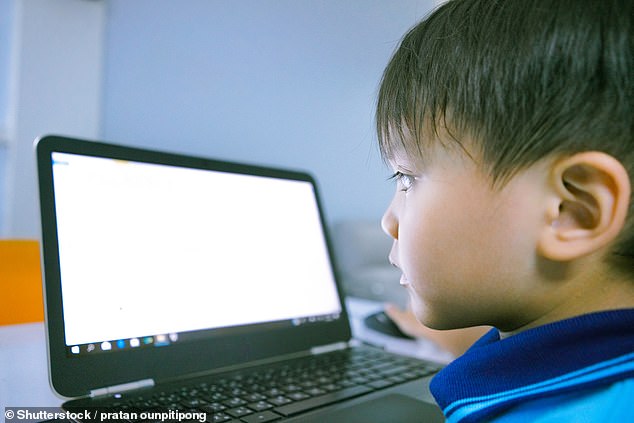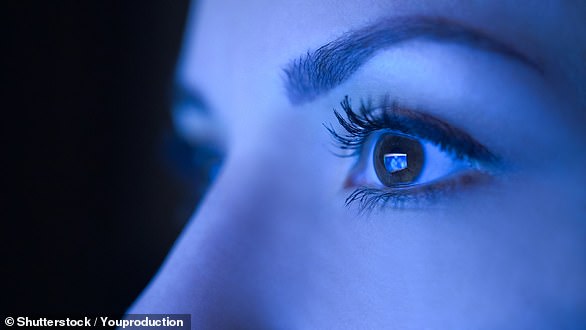Spending too long staring at a smartphone or computer screen can increase the risk of short-sightedness in children by up to 80 per cent, a new study has warned.
More than 3,000 studies investigating smart device exposure and short-sightedness in children and young adults aged between three months old and 33 years old, were examined by experts from Anglia Ruskin University in Cambridge, England.
Researchers found a clear link between time spent looking at a phone or tablet and a greater risk of developing myopia, or short-sightedness in those age groups.
Smartphones alone increase the risk by 30 per cent, but when combined with excessive computer use, the risk increased to 80 per cent over no screen use.

Spending too long staring at a smartphone or computer screen can increase the risk of short-sightedness in children by up to 80 per cent, a new study has warned
KEY FINDINGS: SCREEN TIME INCREASES EYESIGHT FAILURE RISK
Through extensive meta-analysis of over 3,000 earlier studies, they explored the link between screen time and risk of short-sightedness.
They were able to determine a 30 per cent higher risk of myopia, or short-sightedness, from smartphones.
When this is combined with all screen types, the risk increases to 80 per cent in children and young adults.
This specifically applies to heavy usage during childhood.
Advertisement
Researchers fear that this could mean that by 2050, half the world may be short-sighted or suffer similar sight-loss problems.
In 2019, the World Health Organisation recommended children under two should not have any screen time.
The global health agency also said that children aged two to five should have no more than one hour a day of sedentary screen time.
But in the same year, a CensusWide survey of 2,000 British families found children were spending an average of 23 hours a week staring at screens.
Numerous earlier studies have suggested that number has vastly increased during the Covid-19 pandemic, as people remained home for work and schooling.
Rupert Bourne, Professor of Ophthalmology and study co-author, said short-sightedness is a health concern that is escalating quickly.
‘Our study is the most comprehensive yet on this issue and shows a potential link between screen time and myopia in young people,’ he said.
‘This research comes at a time when our children have been spending more time than ever looking at screens for long periods, due to school closures.
‘It is clear that urgent research is needed to further understand how exposure to digital devices can affect our eyes and vision.
‘We also know that people underestimate their own screen time, so future studies should use objective measures to capture this information.’
The systematic review of earlier studies found that there was little detail of smartphone and tablets independent of other screen types, such as laptops and TV.

Smartphones alone increase the risk by 30 per cent, but when combined with excessive computer use, the risk increased to 80 per cent over no screen use
The fact that most studies did not categorise smart devices as an independent risk factor is understandable, the authors wrote, as these devices are relatively recent, in terms of the decades of research they reviewed.
However, they said children using smartphones and tablets spend longer using them and hold the screens closer to them than books or other devices.
They recommended that future studies aim to investigate smart devices independently to better understand their effects on ocular health.
The study was published in The Lancet Digital Health.
Exposure to blue light from phones and computer screens ‘makes it harder to fall asleep’
Leading Optometrist, Dhruvin Patel is a specialist in the impact of blue light on eye health – that is light produced by phone and computer screens.

Blue Light can make it harder to fall asleep and have an impact on the health of eyes
Researchers say exposure to blue light could increase the risk of damage to eyesight and make it harder to fall asleep.
Patel shared his tips for minimising the impact from blue light while working from home or using screens.
1. Work an arm’s length from the screen
Fully extend your arm and work from a distance – looking from your eyes to the end of your fingertips.
Use this as a minimum distance to reduce the stress on your eyeballs.
2. 20/20/20
Simply put, every 20 minutes, look away from the screen for a minimum of 20 seconds at least 20 feet away.
This will help to reset your visual systems and eye through any long periods of screen work.
3. Screen height
Height and level of your working screen can have a big impact on eye strain.
Research has shown that it is better for the screen to be located higher than the users’ watching level – the middle point should be 5-6 inches below the straight line of the users’ vision.
This makes the space between upper and lower eyelid more open, often resulting in dryness of the eyes.
4. Lighting
Position the computer screen to avoid glare, particularly from overhead lighting or windows.
Use blinds or drapes on windows and replace the light bulbs in desk lamps with bulbs of lower wattage and intensity.
If there is no way to minimise glare from light sources, consider using an anti glare filter.
5. Put a post-it note on your screen titled ‘BLINK’.
Normally, in a minute, we blink up to 20 times. This is controlled automatically by our central nervous systems so we’re not conscious of blinking.
While on screens, this is actually reduced to 3-5 times a minute meaning our tear films cannot be maintained and the eye does not remain lubricated.
A post-it-note on your monitor saying ‘Blink’ should help you consciously make an effort to blink. It’s simple but definitely works.
6) Consider your device
Usually the biggest, newest phone is best, but not for your eyes. An iPhone X is 20 per cent brighter than an iPhone 6 and emits higher levels of blue light.
This is the difference of a 100 per cent increase in harmful blue light exposure!
7. Remember to switch off
I would suggest no digital devices or artificial lighting after sunset. If you’re like most people, you’re probably sending that last minute email or finishing your favourite show on Netflix before bed.
Try reading a book or start that meditation that you promised yourself you will do in the new year.
Dhruvin Patel says you shouldn’t assume that ‘night mode’ or ‘blue shade’ on devices is enough to counter the impact of blue light.
He said this ‘has been proven to not aid sleep compared to a screen’s normal output’ and so even with it enabled you should still avoid the screen after sunset if at all possible.
Patel founded a company called Ocushield that produces screen protectors to filter out blue light based on his research into the impact of the light source.
Source: Dhruvin Patel (Ocushield)
Advertisement
Source link : https://www.dailymail.co.uk/sciencetech/article-10070219/Staring-phone-screens-long-increase-risk-short-sightedness.html











